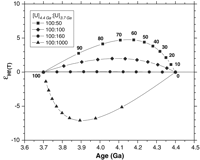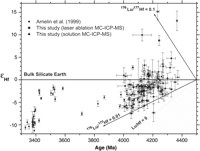Heterogeneous Hadean Hafnium: Evidence of Continental Crust at 4.4 to 4.5 Ga
+ Author Affiliations
- ↵* To whom correspondence should be addressed. E-mail: mark.harrison@anu.edu.au
Abstract
The long-favored paradigm for the development of continental crust is one of progressive growth beginning at ∼4 billion years ago (Ga). To test this hypothesis, we measured initial 176Hf/177Hf values of 4.01- to 4.37-Ga detrital zircons from Jack Hills, Western Australia. ϵHf (deviations of 176Hf/177Hf from bulk Earth in parts per 104) values show large positive and negative deviations from those of the bulk Earth. Negative values indicate the development of a Lu/Hf reservoir that is consistent with the formation of continental crust (Lu/Hf ≈ 0.01), perhaps as early as 4.5 Ga. Positive ϵHf deviations require early and likely widespread depletion of the upper mantle. These results support the view that continental crust had formed by 4.4 to 4.5 Ga and was rapidly recycled into the mantle.
A fundamental question of Earth's evolution is: When did the growth of continental crust begin? One model is that the first crust formed after 4 Ga and grew slowly until the present day (1, 2). This view reflects the absence of a >4-Ga rock record (3) and the broadly coherent post–4 Ga evolution of depleted mantle 143Nd/144Nd (4) and 176Hf/177Hf (5). Long-standing observations of early Nd (6) and Hf (7, 8) depletions, however, leave open the possibility of even earlier global fractionations. Another view (9, 10) is that continental crust was widespread during the Hadean Eon [the first 500 million years (My) of Earth history]. In such a scenario, the lack of direct evidence of earlier depletion events reflects subsequent remixing. Detrital zircons from Jack Hills, Western Australia, with 4.0- to 4.4-Ga U-Pb ages (11–13) represent pieces of crust that have been sequestered for up to ∼4.4 Ga. Hf isotopic compositions vary because of radioactive decay of 176Lu, and such variations in zircons constitute an excellent tracer of Earth's crust/mantle differentiation. This is because zircons have very low Lu/Hf ratios and thus record near-initial 176Hf/177Hf at the time given by their U-Pb age. Amelin and co-workers (14) investigated Hf isotopes in Jack Hills zircons as old as 4.14 Ga and inferred the existence of reworked Hadean crust. We have now extended this application by undertaking Lu-Hf analyses of grains ranging in age up to 4.37 Ga, thereby narrowing the gap to less than 200 My from the end of Earth's accretion to the first mineral record. We document significant Hf isotopic heterogeneity during the early Hadean and conclude that major differentiation of the silicate Earth, possibly the formation of continental crust with a volume similar in magnitude to the present day, may have occurred by 4.4 to 4.5 Ga.
Using the multicollector Sensitive High Resolution Ion Microprobe II, we have surveyed the radiogenic 207Pb/206Pb (207Pb/206Pb*) ratio of over 50,000 Jack Hills zircons separated from a large conglomerate sample (JH992) obtained from the original locality of Compston and Pidgeon (11). Hadean grains thus identified were dated by the U-Pb method (11–13). Zircons between 4.01 and 4.37 Ga were then analyzed for Lu/Hf and Hf isotopic composition (tables S1 and S2). Although 207Pb/206Pb* ages can be variable within Hadean zircons (11–13), it is rarely the case (15) that an individual grain exhibits more than two generations of crystal growth. In the cases of concordant or nearly concordant (<12% discordant) results, we assume that the 207Pb/206Pb* age records the time of crystallization, which we then use to calculate ϵHf(T), where T is age. For grains that showed evidence of zoning or yielded apparent ϵHf(T) values that strongly deviated from those of bulk Earth, we undertook additional ion microprobe dating investigations to assess whether multiple generations of zircon growth were present (table S2 and fig. S2).
Of the 104 multicollector–inductively coupled plasma–mass spectrometry (MC-ICP-MS) zircon 176Hf/177Hf results we present, 44 were measured by solution MC-ICP-MS (table S1) (16) and 60 by laser ablation MC-ICP-MS (table S2) (16). We deliberately used both approaches, because each has potential limitations that are in part compensated for by the other. Solution MC-ICP-MS provides a bulk Hf isotope composition, but does not suffer from isobaric interferences on 176Hf from Yb and Lu. Although laser ablation MC-ICP-MS measurements require peak stripping to correct for Yb and Lu interferences on 176Hf, they allow spatially resolved analysis using spots of 60 to 80 μm in diameter, which facilitates the identification of zircons zoned with respect to 176Hf/177Hf. Because these analyses retain some of the zircon under analysis, subsequent ion microprobe investigations of potential age heterogeneity are possible.
We calculated ϵHf(T) using the “terrestrial” 176Lu decay constant (λ176) of 1.867 ± 0.008 × 10–11 year–1 [(17) and references therein] and the present day chondritic parameters 176Lu/177Hf = 0.0332 ± 0.0002 and 176Hf/177Hf = 0.282772 ± 29 (18) [λ176 and solar system initial 176Hf/177Hf deduced from meteorite Lu-Hf isochrons appear to reflect irradiation effects in the solar nebula (19)]. Using the chondritic averages of Patchett and co-workers (20) instead would not significantly change our calculated values of ϵHf(T), because their 176Hf/177Hf and Lu/Hf values all fall on the same 4.5-Ga isochron as those in (18).
Our data (tables S1 and S2) show a high degree of Hf isotope heterogeneity, with variation in ϵHf(T) values at 4.2 Ga of over 20 ϵ units. Before we examine the geological significance of these data, we investigate possible artifacts of combined interpretation of Lu-Hf and U-Pb systematics in a complex zircon population that could lead to incorrect inferences of early deviations from chondritic evolution. A key link in using zircon to assess initial Hf isotopic ratios is that the age ascribed accurately reflects the time at which the Hf isotopic composition was incorporated into the zircon. In the case of a zircon zoned in U-Pb age, relating an older age component to the bulk Hf isotope composition could result in an incorrect estimate of ϵHf(T).
For example, consider the case of grain CU05 8.5, which yields an ion microprobe age of 4123 ± 18 Ma and age-corrected solution MC-ICP-MS 176Hf/177Hf = 0.280415 ± 0.000015 (2 SE) (table S1), corresponding to an apparent ϵHf(T) = +10.7 ± 0.5. However, because the bulk solution ICP-MS 207Pb/206Pb age is only 3624 Ma (21), we infer that this grain is substantially heterogeneous with respect to age and that the ∼4.1-Ga ion microprobe date represents only a small portion of the total U-Pb system. If we instead use the bulk 3.62-Ga age, the apparent ϵHf drops to a near–bulk Earth value of +1.2 ± 0.5. We thus eliminated this sample from further consideration.
Less obvious is that mixtures of concordant components with contrasting U concentrations each plotting on bulk Earth could also yield substantial positive and negative deviations in ϵHf. This is because of the strongly nonlinear relationship between 207Pb/206Pb* (or Pb/U) and age, whereas the long half-life of 176Lu resulted in essentially linear growth in 176Hf/177Hf over the past 4.56 Gy. To assess this effect, we developed a model in which concordant core (T1) and rim (T2) ages are characterized by ϵHf(T) at T1 and T2, respectively. If the bulk age of this composite is characterized by a U-Pb date obtained by ion microprobe spot analysis in the core, but associated with a 176Hf/177Hf ratio that is a mixture of the two end-members, an incorrect value of ϵHf results. Even in the case for which U-Pb age and Hf isotopes are measured on the same spot overlapping these two zones, aberrant values can result. Figure 1 illustrates possible trajectories in ϵHf(T) resulting from mixing two such components. Because variations in U concentration are far greater than those in Hf concentration (22), we only varied U concentrations.
Results of a model illustrating possible trajectories in ϵHf(T) versus age space ensuing from mixing zircon components of differing age, U concentration, and Hf isotope composition. The model assumes concordant ages of T1 (core) and T2 (rim), which are characterized by the Hf isotope composition of bulk Earth at T1 and T2, respectively. Mixtures of the two components are shown adjacent the relevant curve in % of the rim component for the case of a 4.4-Ga core and 3.7-Ga rim. Where the bulk age of a mixture is characterized by a U-Pb age in the core, but incorrectly associated with a 176Hf/177Hf ratio that is a mixture of the two end-members, the potential exists for incorrect ϵHf values to be calculated. More surprising is that in the case where U-Pb age and Hf isotopes are measured on the same spot overlapping these two zones, aberrant values result, as shown in the mixing curves.
Consider the case of a 4.4-Ga core (176Hf/177Hf4.4 Ga = 0.279930) and a 3.7-Ga rim (176Hf/177Hf3.7 Ga = 0.280398) (i.e., an age contrast of 1 half-life of 235U). Mixtures of these two components between 0 and 100%, shown in 10% increments, are indicated by the black symbols (Fig. 1). The variation in symbol shape represents differing U concentrations of the 4.4-Ga core (T1) and the 3.7-Ga rim (T2). For the case of equal U concentration (diamonds), mixing produces a roughly symmetric trajectory in positive ϵHf space, reaching an ϵHf value of +2 at ∼4 Ga. Doubling the U concentration in the core relative to the rim (squares) increases the apparent ϵHf value to close to +5. This is expected because the Hf isotope composition at every intermediate position is associated with an older apparent 207Pb/206Pb* age and thus appears to originate in a higher Lu/Hf environment. Where the rim U concentration is a factor of 1.6 greater than in the core (circles), no variation from bulk Earth is seen (because 207Pb/206Pb* drops by a factor of 1.6 for each half-life of 235U). Thus, the reduced rate of generation of Pb* at 3.7 Ga is in this case exactly offset by the 160% greater U content of the rim. Where U in the core is 10 times less than in the rim (triangles), ϵHf values as negative as –7 result.
For many grains analyzed by laser ablation MC-ICP-MS, further age investigations are possible, because the method is not completely destructive, compared with solution chemistry. Grains with calculated ϵHf that differ from bulk Earth by more than 5 ϵ units were, where sufficient sample remained, redated near their rims to assess age homogeneity. In the majority of cases, 207Pb/206Pb* ages were reproduced at a satisfactory level (table S2). In one case (RSES17 2.9), we were able to resolve a time-dependent 176Hf/177Hf signal that dropped by 4 ϵ units upon penetrating a 3469 ± 12–Ma rim from a 4127 ± 64–Ma core, yielding ϵHf(4.13 Ga) = 10 ± 1.3 (table S2 and fig. S1).
Where rims are demonstrably younger than core ages, we were able to rule out mixing between domains by the lack of a time-resolved variation in the 176Hf/177Hf signal and by visual evidence from imaging studies. Even where mixing may have occurred below our ability to resolve time variations in 176Hf/177Hf, we have ruled out this effect as a cause for overestimating variations in ϵHf(T) from bulk Earth by using our mixing model (table S2, comments). For example, grain ANU39 15.15 yields a 207Pb/206Pb age of 4234 ± 10 Ma (0% discordant), which corresponds to a high apparent ϵHf(T) of 15.3 ± 1.8 (table S2 and fig. S2). Both the ion microprobe spot for the U-Pb age and the laser ablation pit for the Hf isotope analysis were obtained from the central portion of the grain, which was imaged as a homogenous core (fig. S2). Although the overgrowth region was later found to yield an age of 3548 ± 10 Ma (table S2 and fig. S2), our modeling shows that the relationship between U concentrations in the core [82 parts per million (ppm)] and rim (440 ppm) would likely increase the estimated value of ϵHf if a portion of the rim had inadvertently been included in the analysis. Thus, the value of ∼+15 is a minimum estimate of the true ϵHf of the grain core.
In four cases, measured 174Hf/177Hf and 178Hf/177Hf were outside accepted values (16), and these data were eliminated from consideration. Figure 2 shows the results for which we are confident that all the aforementioned effects have not affected the true ϵHf values. Concordant or near-concordant results are shown as solid symbols, whereas >12% discordant results are shown as open symbols. The diagonal line extending into the negative ϵHf field from an age of 4.5 Ga, labeled Lu/Hf = 0, demarcates the “forbidden region,” corresponding to Lu/Hf < 0. Data plotting near this line must have been derived from an environment in which Lu was essentially completely fractionated from Hf shortly after Earth formation. If that event was the formation of continental crust, then the average continental crust 176Lu/177Hf value of ∼0.01 (23) is a more appropriate comparator. The many results that plot along this line require formation of an enriched reservoir by 4.4 to 4.5 Ga.
Plot of ϵHf(T) versus age for new MC-ICP-MS Hf isotope analyses together with results of Amelin and co-workers (14) recalculated using the “terrestrial” 176Lu decay constant (17). Solid symbols are concordant to <12% discordant, whereas open symbols are >12% discordant. The line marked Lu/Hf = 0 corresponds to 176Hf/177Hf ratios equivalent to the bulk silicate Earth value at 4.5 Ga. The stippled region indicates values not attainable (i.e., lower than solar system initial 176Hf/177Hf). Error bars indicate 2 SE.
Positive ϵHf(T) deviations observed in the same age interval have not previously been documented (14) and imply derivation from reservoirs with high Lu/Hf ratios. These data almost surely reflect the rapid development of depleted mantle with single-stage 176Lu/177Hf ratios within the possible range of values (0.05 and 0.2) for rocks residual from mantle melting (24). Whereas the depleted signature we observe is roughly symmetrical with the enriched reservoir (Fig. 2), negative ϵHf values outnumber positive ϵHf by 2.5:1. This is in part expected, because rocks originating from a source with a depleted signature are less petrogenetically suited to crystallizing zircon.
Most models for the growth of continental crust have emphasized delayed, slow growth (1, 2, 4). The existence of Hadean Jack Hills zircons has been known for 20 years (11) but has been largely considered as a curiosity rather than a fundamental record of the origin of continental crust (25). Investigations of Jack Hills zircons [δ18O, inclusion assemblages, zircon thermometry (12, 13, 26–28)] indicate that the vast majority formed in a continental environment (26) characterized by two forms of convergent margin magmatism (crustal anatexis and calcalkaline magmatism at or close to water saturation) throughout the Hadean. Together, these data indicate that Earth was experiencing continental crust formation during the Hadean and that a mature sediment recycling system similar to that of the known era of plate tectonics had developed by ∼4.4 Ga.
Jack Hills zircons are largely of continental origin (12, 13, 26–28), and our preferred interpretation of the variation of ϵHf(T) (Fig. 2) is that a major differentiation event occurred at 4.4 to 4.5 Ga, producing continental crust and a complementary depleted mantle reservoir. Because the production of modern continental crust is intimately connected with orogenic magmas, our interpretation implies that plate boundary interactions may have begun within the first ∼100 My of Earth history. If the relative fraction of depleted versus enriched samples (Fig. 2) is representative of the general ongoing process, the volume of depleted mantle must have been a substantial fraction of the silicate Earth.
Positive ϵHf(T) deviations of +15 at ∼4.2 Ga imply a reservoir with Lu/Hf of ∼0.1 (Fig. 2). This extrapolates to ϵHf of over +200 today, whereas values as negative as –7 at 4.2 Ga project to ϵHf(0) of about –100. No evidence for these reservoirs has yet been recognized in the post-Hadean rock record (5, 29). Although it is conceivable that such reservoirs exist but have remained hidden for 4 Gy (30), their disappearance is well explained by the recycling of continental crust during the Hadean at rates ∼10 times greater than those at present (9, 31), coupled with vigorous stirring in a hotter and thus less-viscous mantle.
Armstrong (9) emphasized that all large terrestrial planets, including Earth, must have immediately differentiated into relatively constant volume core, depleted mantle, enriched crust, and fluid reservoirs. Recent investigations of 142,143Nd/144Nd variations indicate that a major silicate differentiation event occurred within 50 to 150 My (32, 33), and possibly even within 30 My (30) of Earth's formation. Our results support the view that continental crust was at least a component of the enriched counterpart that formed at ∼4.5 Ga, but this original crust was largely recycled back into the mantle by the onset of the Archean (<4 Ga).
Supporting Online Material
www.sciencemag.org/cgi/content/full/1117926/DC1
Materials and Methods
Figs. S1 and S2
Tables S1 to S3
References
- Received for publication 25 July 2005.
- Accepted for publication 2 November 2005.




